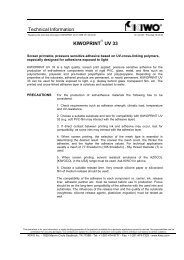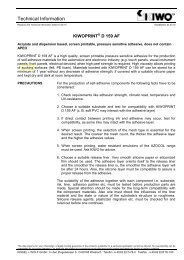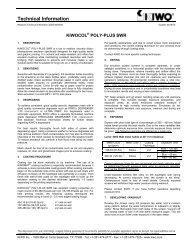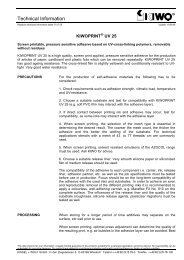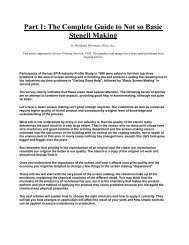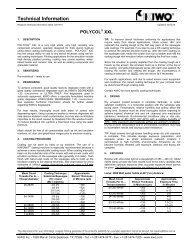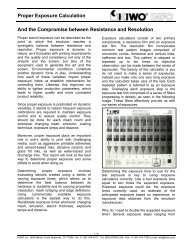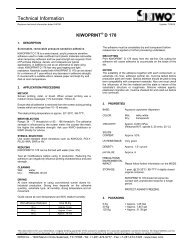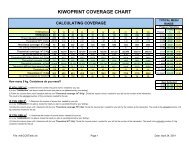Choosing the Right Emulsion for Your Application - KIWO
Choosing the Right Emulsion for Your Application - KIWO
Choosing the Right Emulsion for Your Application - KIWO
Create successful ePaper yourself
Turn your PDF publications into a flip-book with our unique Google optimized e-Paper software.
Length of print runThe longer <strong>the</strong> print run is, <strong>the</strong> more resistant <strong>the</strong> stencil has to be in both aspects,mechanical and chemical resistance. Some stencil systems can be rated <strong>for</strong> a certainlength of print run.Ink typeThere is a distinct trend towards two ink systems: water-based inks and UV-inks. Eachrequires a certain chemical resistance of <strong>the</strong> stencil. O<strong>the</strong>r applications such as ceramicprinting require high abrasion resistance, again o<strong>the</strong>r applications don’t required highchemical resistance at all, such as plastisol inks. Determine how "tough" <strong>the</strong> ink really isand choose an appropriate stencil. Probably <strong>the</strong> toughest ink systems are water-basedinks with solvents in <strong>the</strong>m.Quality requirements of <strong>the</strong> applicationEach application can be rated in <strong>the</strong> grade of quality requirements. A banner that flies on abuilding 30 feet above <strong>the</strong> ground does not necessarily require extremely sharp edges on<strong>the</strong> print, whereas a membrane switch has to have perfectly sharp edges. Printing a posteror four color process required a different type of stencil than a printed circuit board.Screen room equipmentMost important is <strong>the</strong> type of exposure system you have. A modern single point metalhalide lamp can usually handle all types of emulsions and quality requirements. Multipointlight sources such as fluorescent tubes require stencils with long exposure latitudeto handle <strong>the</strong> light undercutting of this type of exposure system. You may even have somespecial systems like a Computer-To-Screen system, a laser exposure unit, or a projectionexposure camera.Mesh countsThe range of mesh counts you may use may determine a certain viscosity in <strong>the</strong> emulsion.Coarse mesh counts require higher viscosity, high mesh counts ask <strong>for</strong> lower viscosity.Some emulsions are not suitable to be coated on fine meshes of coarse mesh counts,whereas o<strong>the</strong>rs may be suitable to handle everything from 63 tpi to 470 tpi.Solvent and water resistanceRequirements to <strong>the</strong> stencilMost stencil systems withstand all solvents used in screen printing. However some lowpriced solvents used as screen wash can contain water and can soften some stencilsystems. Very critical though is <strong>the</strong> high humidity in some many sou<strong>the</strong>rn states. Highhumidity in <strong>the</strong> print shop requires some water resistance of <strong>the</strong> stencil system used. If<strong>the</strong> stencil is affected by humidity, <strong>the</strong> emulsion becomes soft and tacky and will finallybreak down.




